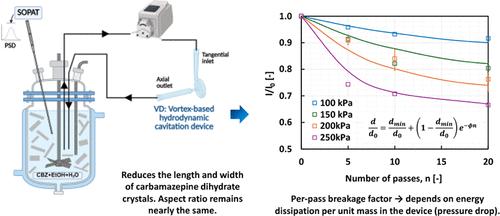Hydrodynamic Cavitation-induced Breakage of Carbamazepine Dihydrate Crystals: Experimental Insights and Modeling
IF 3.9
3区 工程技术
Q2 ENGINEERING, CHEMICAL
引用次数: 0
Abstract
Downstream milling is often employed to control the particle size distribution (PSD) of crystalline products. Recently, hydrodynamic cavitation (HC) was shown to be quite effective for particle breakage compared to traditional wet milling and acoustic cavitation. In this work, we investigated the use of HC for tailoring the size and shape of carbamazepine dihydrate (CBZ-DH) crystals. A vortex-based HC device (VD) was used. An endoscopic optical probe (SOPAT GmbH, Germany) was used to measure the PSD during the breakage experiments. The variation in mean length, width, and aspect ratio (AR) of CBZ-DH crystals as a function of the number of passes through the VD was quantified. The breakage of CBZ-DH crystals exhibited two regimes─initially fast breakage up to a certain number of passes, followed by a significantly slower breakage. An empirical correlation for estimating the reduction in the mean length and width of the crystals was developed. The HC-induced breakage was modeled using the population balance model (PBM). The model successfully simulated the experimental PSD across all operating conditions with an appropriate selection of breakage model parameters. The data and models presented in this work provide a useful basis for tailoring pharmaceutical crystals by using VD.

水动力空化诱导的卡马西平二水合物晶体断裂:实验见解和模型
下游磨粉通常用于控制结晶产品的粒度分布。近年来,与传统的湿磨和声空化相比,水动力空化(HC)对颗粒破碎非常有效。在这项工作中,我们研究了使用HC来定制二水合卡马西平(CBZ-DH)晶体的大小和形状。采用了一种基于涡流的HC装置(VD)。在破裂实验中,使用内镜光学探针(SOPAT GmbH,德国)测量PSD。我们量化了CBZ-DH晶体的平均长度、宽度和纵横比(AR)随通过VD次数的变化。CBZ-DH晶体的断裂表现出两种状态──最初的快速断裂达到一定的次数,然后是明显较慢的断裂。开发了一种用于估计晶体平均长度和宽度减少的经验相关性。采用种群平衡模型(population balance model, PBM)对hc引起的断裂进行建模。该模型通过适当选择破碎模型参数,成功地模拟了所有工况下的试验PSD。本工作提供的数据和模型为用VD法定制药物晶体提供了有用的基础。
本文章由计算机程序翻译,如有差异,请以英文原文为准。
求助全文
约1分钟内获得全文
求助全文
来源期刊

Industrial & Engineering Chemistry Research
工程技术-工程:化工
CiteScore
7.40
自引率
7.10%
发文量
1467
审稿时长
2.8 months
期刊介绍:
ndustrial & Engineering Chemistry, with variations in title and format, has been published since 1909 by the American Chemical Society. Industrial & Engineering Chemistry Research is a weekly publication that reports industrial and academic research in the broad fields of applied chemistry and chemical engineering with special focus on fundamentals, processes, and products.
 求助内容:
求助内容: 应助结果提醒方式:
应助结果提醒方式:


